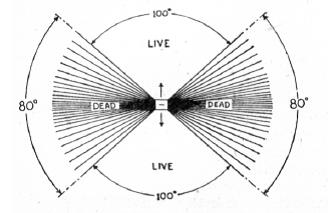RADIO
Back in the 1950s the iconic Marconi AX ribbon microphone was the main tool for BBC drama production. Actors were familiar with its figure of eight characteristics, and would utilise the dead zones at the sides of the mic to great effect. Noisy page turns could be avoided by holding the script to the side of the mic. The impression of going off into the distance could be achieved by simply delivering the lines whilst slowly moving to the side of the microphone. Shouting from a distance could be managed in the same way. Actors were also very conscious users of proximity effect, moving closer or further from the microphone as the script required.
 BBC Training Manual 1942
BBC Training Manual 1942
Bearing this in mind an elderly ex-BBC producer told me the following delightful tale about a well- known actor of the day.
Whenever a trainee or inexperienced engineer was spotted entering the control booth he would go through the same entertaining routine. On being asked to deliver some lines to test the mic, he would start speaking in a fairly quiet voice whilst very gradually moving his head round the side of the mic. All the while the hapless young knob- twiddler in the control booth would be increasing the gain on the input. When our actor judged that the gain was almost certainly up full he would deftly swing his head back to the front of the mic and inquire in rich, thespian tones, (as if addressing the back row of the gallery) ‘HOW’S THAT FOR LEVEL?!!’
FILM
In the early days of talking pictures, years before the invention of the shotgun microphone, considerable use was made of the directional characteristics of figure-of-eight ribbon microphones to minimise the pick- up of unwanted noise on the set. Cameras and other noisy equipment could be positioned in the dead zones. This greatly improved the quality and intelligibility of the end product. It also made it possible (using more than one microphone) to balance the levels of different performer’s voices. This had not previously been possible using Omni-directional models.
Filming in locations with high levels of surrounding ambient noise, a figure-of-eight could be suspended horizontally above the actors’ heads. The back of the mic faced upwards (away from the sound sources) and the front faced downwards towards the actors. In this position the dead zone effectively attenuated 360 degrees of surrounding noise!
These days, when recording studios seem to be generally stuck in Cardioid mode, I thought it might make a pleasant change to revive some of these vintage figure-of-eight techniques. In the following episodes I shall take a look at more uses for this versatile but somewhat neglected polar pattern.
